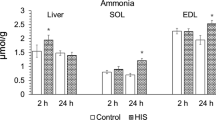Abstract
The effect of sodium dichromate on cellular metabolism was investigated. Intraperitoneal injection of sodium dichromate into the rat (20 or 40 mg/kg) caused significant increases in serum lactate, pyruvate, and creatinine concentrations within 15 min after intoxication. Severe hyperglycemia occurred thereafter, as a result of increased hepatic glycogenolysis, which was seen in the first 2 h after dichromate. However, liver glycogen was resynthesized in 24 h-fasted rats after glucose refeeding. Dichromate decreased serum total amino acids, with a consequent increase in blood urea nitrogen (BUN) concentration. Unlike HgCl2 (2 mg/kg, i.p.), As2O3 (5 mg/kg, i.p.), and KCN (5 mg/kg, i. p.), dichromate showed the largest metabolic disturbance only in the early period after treatment. In addition, dichromate produced cyanosis, which appeared during the period of the accelerated glycolysis and breakdown of creatine phosphate. Regardless of chemical species, only the hexavalent chromium compounds had an effect on the cellular metabolism. Trivalent chromium compounds had no effect at all. These results suggest that dichromate possesses a characteristic dual action on cellular metabolism, which might be related to its metabolic fate.
Similar content being viewed by others
References
Baines AW (1965) Cell renewal following dichromate induced renal tubular necrosis. Am J Pathol 47: 851–876
Berndt WO (1975) The effect of potassium dichromate on renal tubular transport processes. Toxicol Appl Pharmacol 32: 40–52
Biber TUL, Mylle M, Baines AD, Gottschalk CW, Oliver JR, Mac-Dowell MC (1968) A study by micropuncture and microdissection of acute renal damage in rats. Am J Med 44: 664–705
Braunwald E (1983) Cyanosis, hypoxia, and polycythemia. In: Petersdorf RG, Adams RD, Braunwald E, Isselbacher KJ, Martin JB, Wilson JD (eds) Harrison's principles of internal medicine, 10th edn. McGraw-Hill, New York, pp 162–167
Carroll NV, Longley RW, Roe JH (1956) The determination of glycogen in liver and muscle by use of anthrone reagent. J Biol Chem 220: 583–593
Connett PH, Wetterhahn KE (1983) Metabolism of the carcinogen chromate by cellular constituents. Structure and Bonding 54: 93–124
Ellis EN, Brouhard BH, Lynch RE, Dawson EB, Tisdell R, Nichols MM, Ramirez F (1982) Effects of hemodialysis and dimercaprol in acute dichromate poisoning. Clin Toxicol 19: 249–258
Evan AP, Dail WG (1974) The effects of sodium chromate on the proximal tubules of the rat kidney; fine structural damage and lysozymuria. Lab Invest 30: 704–715
Goyer RA (1986) Toxic effects of metals. In: Klaassen CD, Amdur MO, Doull J (eds) Casarett and Doull's toxicology; the basic science of poisons, 3rd edn. Macmillan, New York, pp 582–635
Gray SJ, Sterling K (1950) The tagging of red cells and plasma proteins with radioactive chromium. J Clin Invest 29: 1604–1613
Gruber JE, Jennette KW (1978) Metabolism of the carcinogen chromate by rat liver microsomes. Biochem Biophys Res Commum 82: 700–706
Hayes RB (1982) Carcinogenic effects of chromium. In: Langard S (ed) Biological and environmental aspects of chromium. Elsevier Biological Press, Amsterdam, pp 221–247
Hirsch GH (1973) Differential effects of nephrotoxic agents on renal organic ion transport and metabolism. J Pharmacol Exp Ther 186: 593–599
Iserson KV, Banner W, Froede RC, Derrick MR (1983) Failure of dialysis therapy in potassium dichromate poisoning. J Emerg Med 1: 143–149
Kaufman DB, DiNicola W, McIntosh R (1970) Acute potassium dichromate poisoning: treated by peritoneal dialysis. Am J Dis Child 119: 374–376
Kitagawa S, Seki H, Kametani F, Sakurai H (1982) Uptake of hexavalent chromium by bovine erythrocytes and its interaction with cytoplasmic components; the role of glutathione. Chem Biol Interact 40: 265–274
Lehninger AL (1982) Principles of biochemistry. Worth, New York, pp 397–434
Mathur AK, Chandra SV, Tandon SK (1977) Comparative toxicity of trivalent and hexavalent chromium to rabbits. II. Morphological changes in some organs. Toxicology 8: 53–61
Peters RA (1955) Biochemistry of some toxic agents. I. Present state of knowledge of biochemical lesions induced by trivalent arsenical poisoning. Bull John's Hopkins Hosp 97: 1–20
Roe JH, Dailey RE (1966) Determination of glycogen with the anthrone reagent. Anal Biochem 15: 245–250
Samitz MH, Scheiner DM, Katz SA (1968) Ascorbic acid in the prevention of chrome dermatitis. Arch Environ Health 17: 44–45
Sayato S, Nakamuro K, Matsui S, Ando M (1980) Metabolic fate of chromium compounds. I. Comparative behavior of chromium in rat administered with Na2 51CrO4 and51CrCl3. J Pharmacol Dyn 3: 17–23
Smith RP (1986) Toxic responses of the blood. In: Klassen CD, Amdur MO, Doull J (eds) Casarett and Doull's toxicology; the basic science of poisons, 3rd edn. Macmillan, New York, pp 223–244
Suzuki Y (1988) Reduction of hexavalent chromium by ascorbic acid in rat lung lavage fluid. Arch Toxicol 62: 116–122
Wiegand HJ, Ottenwälder H, Bolt HM (1984) The reduction of chromium(VI) to chromium(III) by glutathione; an intracellular redox pathway in the metabolism of the carcinogen chromate. Toxicology 33: 341–348
Yamamoto A, Wada O, Ono T (1981) A low-molecular-weight, chromium binding substance in mammals. Toxicol Appl Pharmacol 59: 515–523
Author information
Authors and Affiliations
Rights and permissions
About this article
Cite this article
Kim, E., Na, K.J. Acute toxic effect of sodium dichromate on metabolism. Arch Toxicol 64, 644–649 (1990). https://doi.org/10.1007/BF01974692
Received:
Issue Date:
DOI: https://doi.org/10.1007/BF01974692



